Ijraset Journal For Research in Applied Science and Engineering Technology
- Home / Ijraset
- On This Page
- Abstract
- Introduction
- Conclusion
- References
- Copyright
Detailed Energy Audit of Thermal Power Plant
Authors: Sudheer Chandra, Tanu Rizvi
DOI Link: https://doi.org/10.22214/ijraset.2022.42651
Certificate: View Certificate
Abstract
This paper presents a model based on physical and structural industrial load control. Lighting is an important service for all industries. Depending on the type of industry, industrial lighting consumes 2 to 10% of total energy. Innovation and continuous improvements in the lighting industry have opened up considerable opportunities for energy efficiency in the area. Lighting is a space that, during the design process, provides a wide range of energy efficiency by combining new & advance energy-saving bulbs, lamps and gears, as well as high performance techniques. It only provides an indication of some of the options a power auditor may consider when conducting an industry analysis. Energy conservation and exploration of new energy options is an acceptable solution to meet the growing demand of industry in the future. The implementation of energy research can improve equipment efficiency and thus reduce energy losses.
Introduction
I. INTRODUCTION
Power availability is a critical factor in the country's economic progress. In today's world, energy is extremely valuable, and India ranks third in the world in terms of overall energy consumption. By 2030, the country's power usage is predicted to exceed 4 trillion units. Fossil fuels, particularly coal, dominate the country's electricity sector. The Indian government is working to enhance renewable energy investment, with a goal of 175 GW capacity by 2022 [1]. As of 31 December 2021, In India, the total installed capacity of electric power generating plants owned by various electric utilities was 393389.46MW. The following is a breakdown of the share of various types of generating stations:
Thermal power plants - 235218.72MW Hydro power plants - 46512.22MW Nuclear power plants – 6780MW Renewable Energy Source - 6780.0MW[3]
In fiscal year 2021, the industry sector consumed the most energy, accounting for 41% of total consumption in India. The domestic sector came in second with 26% of the vote. Traction and railways, on the other hand, accounting for 1% of India's total electricity consumption. [3] Energy conservation entails lowering energy usage without compromising quantity or quality. A comprehensive energy management programme starts with energy conservation, which leads to proper equipment rating, the adoption of max-efficiency technology, and a shift in habits that waste a lot of energy. [4] Problem rise in electrical equipment due to many factors such as ageing of the device, ageing of the wires used, dust factor, humidity, and various factors, the quality and performance of this electrical system is distorted [5]. As an outcome, electrical energy is lost and transformed to heat energy, lowering system efficiency and increasing power consumption. It is possible to bring down losses by using the methodology energy audits, which aids in determining the overall operation of the electrical system. If there are any leaks, they will be discovered and repaired. As a result, the methodology energy auditing activity will aid in the long-term durability of electrical and electronic equipment [6].
Vandana global limited, Power plant industrial area phase-2, Siltara Raipur, Chhattisgarh, undertook an energy audit to determine the power plant's energy usage and losses in the lighting sector. Energy Audit can include a variety of activities, depending on the type of energy assessment and the objectives of the energy research center. The power test can start by looking at the electrical account to see how much energy is used. The study was conducted by various researchers with a variety of methods to assess energy consumption in [7], who said that by using the results of energy research they could strive to reduce their energy costs by reducing costs. Energy auditing is needed to reduce energy debt and reduce energy losses. Governments should take steps to make periodic inspections of industrial buildings compulsory. [8] Electricity is a very important factor in private and public health. Power testing is a useful way to determine the energy consumption of a building and to determine the best solution. Regular power inspections will expose energy consumption and waste, and help identify new energy saving opportunities. [9] Decreased energy consumption indicates a decrease in carbon emissions. Power assessment is a powerful tool for identifying and evaluating a complete energy management system. Energy Auditing is a compelling tool for isolating and evaluating a complete energy management system. This approach can be important in an industry that is cost-effective and costs a few different benefits such as improved creativity, higher profitability, better quality, and the most important fulfillment of the goal of saving energy in the world.
A. Energy Audit
An energy audit examines a building's energy usage in order to determine the elements that contribute to increased energy consumption. The information acquired during the inspection serves as the foundation for the suggestions made to reduce energy expenditures. An energy audit entails a complete walkthrough inspection by a qualified energy auditor, who will then offer a report detailing their findings as well as proposals for energy efficiency improvements. [10]
An energy audit allows us to better understand how electricity is used in the industry and to find out locations wherever energy is wasted and where there is opportunities for improvement. An energy audit must meet the following criteria: [11, 12]
- Calculated, current energy consumption data
- A complete analysis of the energy consumption profile
- Instead of a simple payback period, include a life-cycle cost.
B. Need of Energy Audit
The demand for electricity is increasing every day. More energy sources will be required to meet this requirement. Fossil fuels produce both energy and pollution, both of which are damaging to humans. [13]. Pollution testing and emission calculators are available online and are used to measure pollution levels and environmental emissions. Strength testing will decrease the environmental effect directly or indirectly [14]. The functions of energy research are,
- an energy audit can lower electricity utilization,
- an energy audit can lower the electricity bill and keep the cash
- an energy audit can enhance the comfort degree
- an energy audit can lessen the carbon emission
- an energy audit can limit useless waste and pollution
Energy testing is a major and important step money. It may seem that organizational power research provides a point of reference for controlling energy use and provides a better system of vital energy use in the organization. [15]
C. Types of Energy Audit
Energy auditing is the most effective way to reduce energy debt and usage in the commercial and non-commercial industries [16]. The type of strength test that must be performed is determined as
- how much penetration and depth required for the final examination
- used industry: its function and type
- the size of the audit and the required amount achieved.
There can be three types of energy audits [17], and they are walk-through energy audits, target energy audits, and detailed energy audits.
D. Walk through Energy Audit
Audit your energy usage. It's also known as a preliminary audit because it's a primitive surveying audit in which the auditor only verifies an organization's energy usage. No substantial steps for energy usage will be made in this type of energy audit. It's the first step in the auditing process, as well as the simplest and least expensive. And it's focused on the regions that use the most energy. [18]. The walk-through energy audit takes less time to complete than spam.
The auditor will locate the energy usage area and compile a comprehensive list of energy-saving strategies [19].
The certified energy manager, certified auditor, or professional engineer is in charge of the walkthrough audit. For finding an Energy saving strategy, walkthrough energy audit details are insufficient. The auditor can operate with greater precision and profitability in less time. The auditor obtains all of the information of an organization from this sort of energy audit, which are then used in a detailed energy audit [20, 21]. The walkthrough energy audit's will include: -
1. Determining energy use in an organization.
2. Determine the amount of energy consumed in a company.
3. A brief interview with the organization's point of contact.
4. During this form of auditing, the only primary problem area will be addressed.
5. To determine the most likely (and easiest) solutions to cut consumption and enhance efficiency metrics [22].
6. To discover improvements and cost cutting opportunities (special/low-cost).
E. Targeted Energy Audit
A walk through energy audit the results of targeted energy tests. A detailed study of a particular project is provided by this research method. This method of energy research varies depending on the type of institution, whether corporate, local, or industrial building, but detailed knowledge and data are required for all sectors.[23,24] The results are suggestions for what action to take. A clear and concise energy report, as well as an application for "how to improve energy efficiency," should be presented. The following are the objectives of targeted energy research:
- Identify the energy use of the organization.
- A brief discussion and contact point for the organization.
- In this study, only targeted area will be considered.
- To determine the most likely methods for improving efficiency measures and reducing consumption (and those that are cheapest to implement) [25].
- To determine the enhancements and cost reductions (distinctive cost).[26]
F. Detailed Energy Audit
A comprehensive energy audit or an investment-grade audit are also terms used to describe this type of assessment. A detailed study of prospective capital-intensive upgrades, including design and control, may be necessary as part of the comprehensive energy audit. A comprehensive energy audit may necessitate collecting data over a long period of time and delivering accurate energy usage and savings statistics so that contractors know exactly what solutions to deploy. [27]. The detailed energy audit was conducted in three parts [28], namely, the pre-audit phase, the audit phase, and the post-audit phase, as shown in Figure 1.
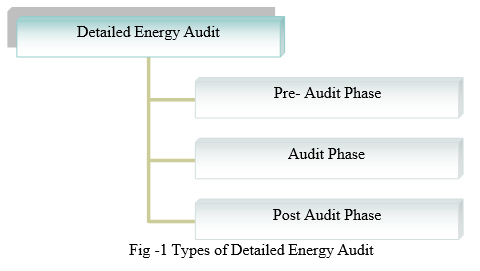
- Pre-Audit Phase
The first phase or step of intensive energy research is the phase of previous research. For the duration of the pre-study phase, the energy auditor plans and arranges the energy audit. all through this step, a proper interview with the chief government officer (CEO), plant manager, energy manager, and challenge supervisor turned into held. At this factor, a brief assembly with all the heads and the proper man or woman is convened. [29]. The Auditor-General or the Auditor-General plans to take the following steps during the previous research phase.
- Discusses the principle of extensive power testing with the site administrator
- Describes the description of the in-depth power research and the data required during the research phase
- Discusses the principle of extensive power testing with the site administrator
- Describes the description of the in-depth power research and the data required during the research phase. The results of this section should assist with the completion of the audit team, staffing objectives from a comprehensive energy audit, and the planning of all detailed energy audits over time.
Under this phase, we schedule a schedule within 1 week where we do observation, evaluation, and analysis industry. The program is given in the following table.
Table -1
Schedule of energy audit phase-1
|
S.No. |
Analysis Observation and inspection |
Result |
|
1. |
Plan & organized a walkthrough audit of plant with plant Manager |
Done |
|
2. |
Conduct a Awareness program with department |
Done |
|
3. |
Organize a survey and monitoring |
Done |
|
4. |
An analysis of Power Consumption |
Done |
|
5. |
Finding and developing energy efficiency opportunities |
Done |
|
6. |
Choosing the instruments that will be utilised in an energy Audit |
See Table |
|
7. |
Inspection and report to upper Management |
See Table |
Table-3 Instruments used for Audit
|
S.No |
Electrical Measuring Instrument |
|
1. |
Lux Meter |
|
2. |
Power Analyser |
|
3. |
Synergy Meter |
|
4. |
Pitot Tube & Manometer |
|
5. |
Contact/Infrared Thermometer |
2. Phase -2 Audit Phase
a. Energy Saving Of Lighting System
Several areas are found during the industry audit as spots where savings are effectively guaranteed. After determining the right places, a lighting count is required. The following are the most popular ways to save energy on lighting systems
- Infrared read Coating halogens replace halogens (spotlights).
- Light Emitting Diode(LED). have taken the place of HPSV lights
- Let natural lighting helps.
- Upgrade HVAC system.
- Metal halides are used to replace halogens (flood type).
- LED tube light can replace fluorescent tube light.
- Magnetic ballasts are being replaced with electronic ballasts.
b. Led Lights In Place Of Old/Defective Lights
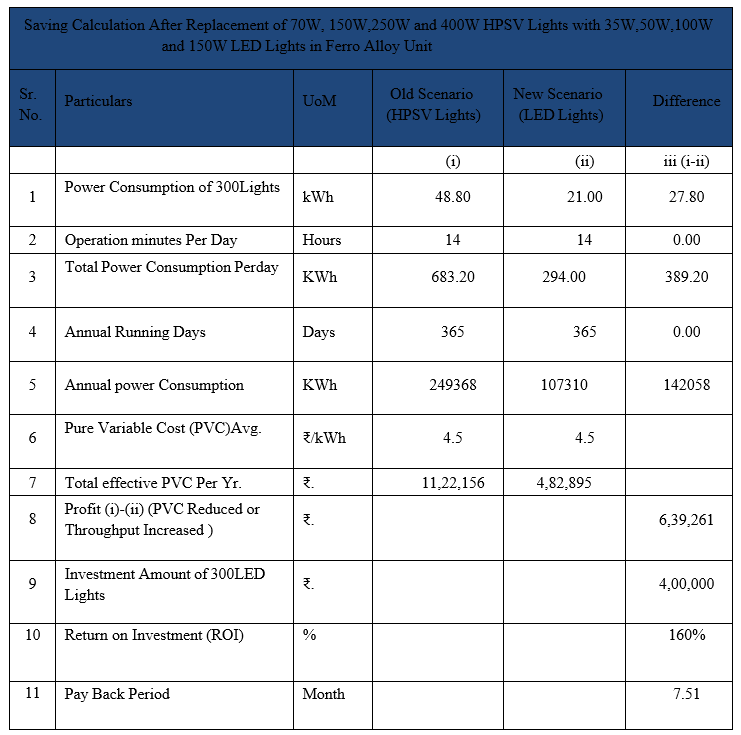
G. Bill Analysis
- Before Replacement
Power consumption by 300 Bulb in 1 hours =48.80kWh Power consumption by 300 Bulb in 1 day =48.80X14
=683.20kWh
Power consumption by 300 Bulb in 365 days= 249368kWh
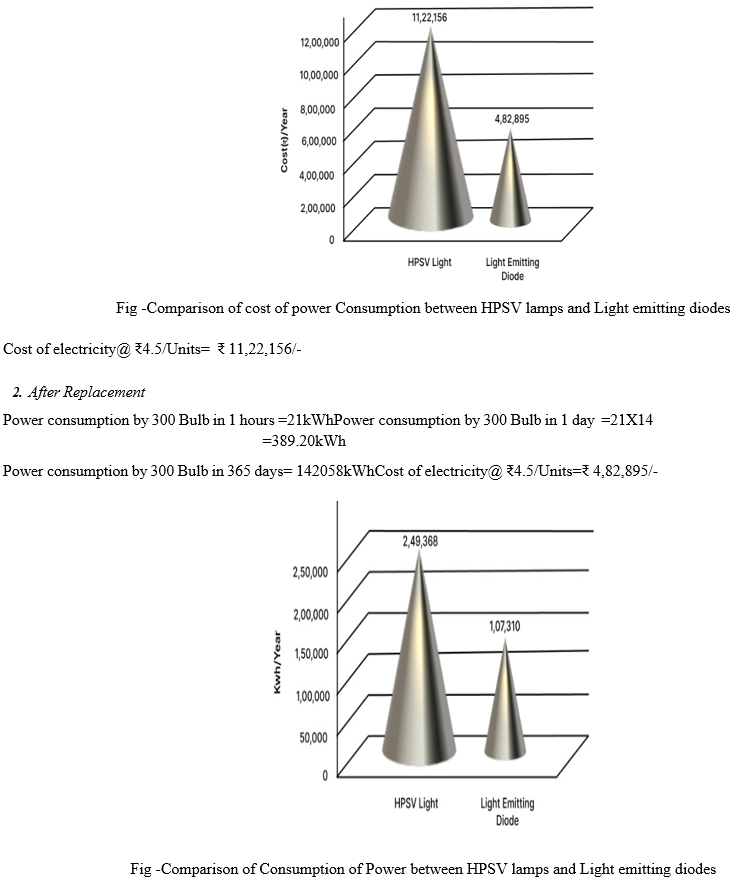
II. ENERGY SAVING ON AIR COMPRESSORS
A. FAD Test for Compressors (Conveying Air)
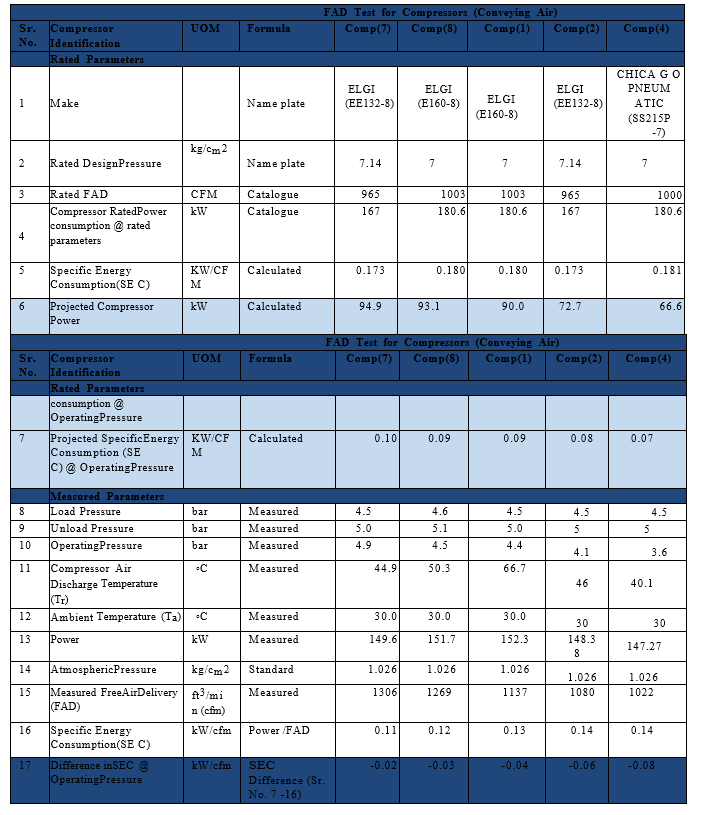
B. Observations
- Actual air flow is more than the rated FAD indicates excessive clearance in air endof the compressor which indicates the deterioration of compressor.
- The Compressor Discharge air Temperature is on a Slightly Higher side. Higher thetemperature, higher will be power consumption.
- Even though Actual Specific energy consumption is less than the rated, it is onhigher side when compared to the projected SEC at operating pressure.
C. Recommendations
- SEC of all Compressors is on higher side which indicates the higher powerconsumption. Hence, recommend to do proper maintenance
- Clean suction filters on weekly basis to avoid extra energy consumption. Change allthe consumables as per the schedule.
- Due to opening of doors, dust accumulated in compressor area & causes morepower consumption. Keep all the doors closed.
???????D. Notable /Remarkable Points for Energy Savings
- Every 4 ° C increase in inlet air temperature leads in a 1% increase in energy consumption to achieve similar output.
- 250 mmWc pressure drop in suction filter increases power consumption by 2 %
3. Manometer / differential pressure gauge should be installed across the suction filter for easily identification of duty suction.
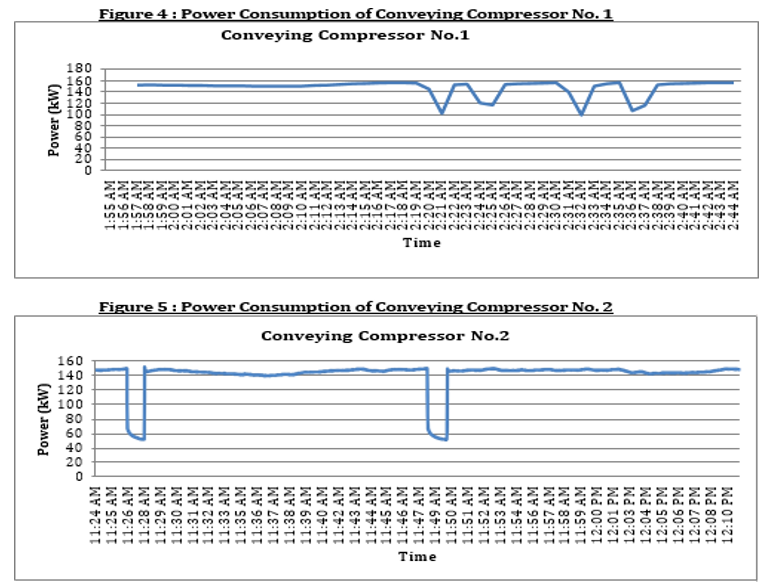
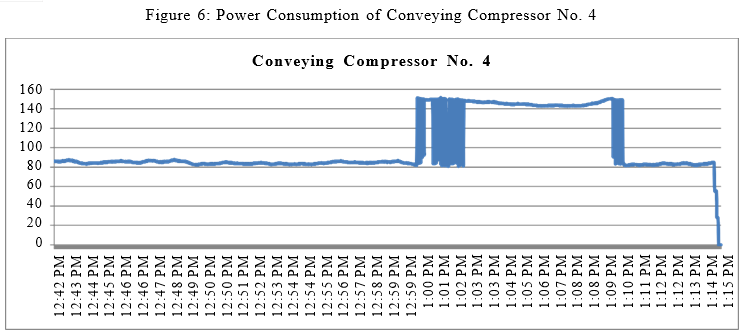
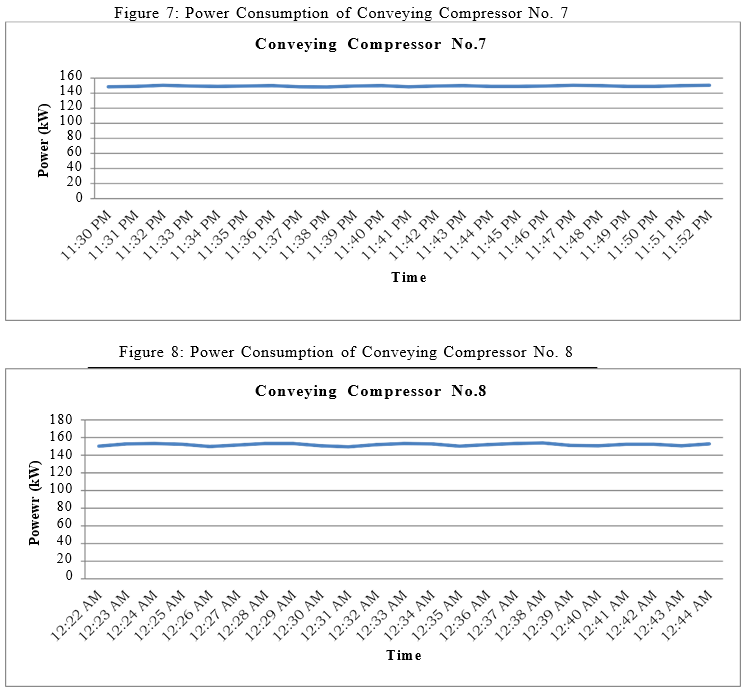
III. ACKNOWLEDGMENT
The author is grateful to M/s Vandana Global ltd’ Siltara Phase-II Raipur CG, for giving chance to conduct an energy audit. I am particularly grateful to Ramnaresh Choubey, assistant manager {energy audit} that help me to write this paper.
Conclusion
\"Energy saved is energy generated,\" says a famous quote. This shows that, in addition to increasing generation capacity at a higher price, an energy audit is required to conserve electricity at a considerably lower cost. Because the demand for electricity is always on the increasing, power companies are under pressure to expand capacity to fulfil the demand. Because industries are the largest electricity consumers, the authors conducted a case study of an industrial unit to achieve this goal. The information presented in this paper demonstrates how we can save electricity by making improvements to the system and making it more energy efficient. The government needs to make an energy audit compulsory for each industrial facility in the country.
References
[1] https://www.nsenergybusiness.com/features/electricity-consuming-countries/#:~:text=1.,China,renewable%20sources%20in%20recent%20years.. [2] https://en.wikipedia.org/wiki/List_of_power_stations_in_India. [3] https://www.statista.com/statistics/1130112/india-electricity-consumption-share-by-sector/ [4] Singh, Malkiat, Gurpreet Singh, and Harmandeep Singh. \"Energy audit: A case study to reduce lighting cost.\" Asian Journal of Computer Science and Information Technology 2.5 (2012): 119-122. [5] A. Ganapathy, G. Soman, Godwin Manoj VM and R. Lekshamana, \"Online Energy Audit and Renewable Energy Management System,\" 2016 International Conference on Computing Communication Control and automation (ICCUBEA), 2016, pp. 1-6, doi: 10.1109/ICCUBEA.2016.7860035. [6] Aithal, Sreeramana. (2015). TECHNIQUES FOR ELECTRIC ENERGY AUDITING IN EDUCATION SYSTEM. International Journal of Management, IT and Engineering ISSN: 2249-0558. 5. 318-325. [7] Kumar, Awanish & Ranjan, Shashi & Singh, M. & Kumari, Priyanka & Lekshmana, Ramesh. (2015). Electrical Energy Audit in Residential House.Procedia Technology. 21. 625-630. 10.1016/j.protcy.2015.10.074 [8] H. H. Sait, “Auditing and analysis of energy consumption of an educational building in hot and humid area,” Energy Convers. Manag., vol. 66, pp. 143- 152 [9] D.I.Doukas and T.Bruce“Energy audit and renewable integration for historic buildings: The case of craiglockhart primary school,” Procedia Environ. Sci., vol. 38, pp. 77–85, 2017, doi: 10.1016/j.proenv.2017.03.081 [10] https://safetyculture.com/checklists/energy-audit/. [11] Ghadi, Yazeed & Baniyounes, Ali. (2018). Energy Audit and Analysis of an Institutional Building under Subtropical Climate. International Journal of Electrical and Computer Engineering. 81. 845-852. 10.11591/ijece.v8i2.pp845-852. [12] Alhamrouni, Ibrahim & Ramli, Firdaus & Salem, Mohamed & Ismail, Bazilah & Jusoh, Awang & Sutikno, Tole. (2020). Optimal power scheduling of renewable energy system in micro-grids using distributed energy storage system. TELKOMNIKA Indonesian Journal of Electrical Engineering. 18. 2158~2168. 10.12928/TELKOMNIKA.v18i4.15159. [13] Baniyounes, Ali & Ghadi, Y.Y. & Baker, A.A.. (2019). Institutional smart buildings energy audit. International Journal of Electrical and Computer Engineering. 9. 783-788. 10.11591/ijece.v9i2.pp.783-788. [14] Abidin, N. I. A., Zakaria, R., Pauzi, N. M., Al Qaifi, G. N., Sahamir, S. R., & Shamsudin, S. M. (2017). Energy efficiency initiatives in a campus building. Chemical Engineering Transactions, 56, 1-6. [15] Sharma, P., Mahajan, R., & Sharma, Y. (2018). Investigation of the Energy Audit Practice in India. [16] Xiao, T., Geng, C., & Yuan, C. (2020). How audit effort affects audit quality: An audit process and audit output perspective. China Journal of Accounting Research, 13(1), 109-127. [17] Kontokosta, C. E., Spiegel-Feld, D., & Papadopoulos, S. (2020). The impact of mandatory energy audits on building energy use. Nature Energy, 5(4), 309-316. [18] Kamara, B., Kamara, S., Sawyer, R., & Kallon, D. (2019, October). Need for Energy Efficiency and Energy Audit of Buildings in Freetown. In 2019 Open Innovations (OI) (pp. 415-419). IEEE. [19] Bureau of Energy Efficiency, “General aspect of energy management and energy audit. Bureau of Energy Efficiency, India,” National Certification examination for energy managers and energy auditors, 2005. [20] Gaonwe, T. P., Kusakana, K., & Hohne, P. A. (2019, October). Walk-through Energy Audit and Savings opportunities: Case of Water Heaters at CUT Residential Buildings. In 2019 Open Innovations (OI) (pp. 434-439). IEEE. [21] Yandri, E., Ariati, R., Uyun, A. S., Setyobudi, R. H., Anne, O., Susanto, H., & Vincevica-Gaile, Z. (2020, April). Implementation of walk-through audits for designing energy management system: A first step towards an efficient campus. In IOP Conference Series: Earth and Environmental Science (Vol. 490, No. 1, p. 012005). IOP Publishing. [22] Hassoune, A., Khafallah, M., Mesbahi, A., Nouaiti, A., & Bouragba, T. (2020). Experimental implementation of a smart battery charger for electric vehicles charging station. International Journal of Power Electronics and Drive Systems, 11(4), 1689. [23] Salkuti, Surender Reddy. (2020). Comparative analysis of electrochemical energy storage technologies for smart grid. TELKOMNIKA [24] (Telecommunication Computing Electronics and Control). 18. 2118. 10.12928/telkomnika.v18i4.14039. [25] Lucchi, E. (2018). Applications of the infrared thermography in the energy audit of buildings: A review. Renewable and Sustainable Energy Reviews, 82, 3077-3090. [26] Kubule, A., Lo?melis, K., & Blumberga, D. (2020). Analysis of the results of national energy audit program in Latvia. Energy, 202, 117679. [27] Mokhtari, F., Semmar, D., Chikhi, M., Merzouk, N. K., & Oukaci, S. (2020). Investigation Of The Improvement Building Envelope Impact On Energy Consumption Using Energy Audit. In MATEC Web of Conferences (Vol. 307, p. 01031). EDP Sciences. [28] Fudholi, A., Musthafa, M. F., Taslim, I., Indrianti, M. A., Manyoe, I. N., & Othman, M. Y. (2019). Efficiency and energy modelling for PVT air collector with extended heat transfer area: a review. International Journal of Power Electronics and Drive Systems, 10(4), 2029. [29] Bagwan, S. U., Makandar, Y. A., Shaikh, S. K., & Jamadar, N. M. (2020, June). Audit and Analysis of Energy Utilization in Engineering Institution Buildings in Maharashtra. In 2020 5th International Conference on Communication and Electronics Systems (ICCES) (pp. 801-805). IEEE. [30] Prabowo, V. S. W., Fahmi, A., Adriansyah, N. M., & Andini, N. (2019). Energy efficient resources allocations for wireless communication systems. Telkomnika,17(4),1625-1634.
Copyright
Copyright © 2022 Sudheer Chandra, Tanu Rizvi. This is an open access article distributed under the Creative Commons Attribution License, which permits unrestricted use, distribution, and reproduction in any medium, provided the original work is properly cited.

Download Paper
Paper Id : IJRASET42651
Publish Date : 2022-05-13
ISSN : 2321-9653
Publisher Name : IJRASET
DOI Link : Click Here
 Submit Paper Online
Submit Paper Online

